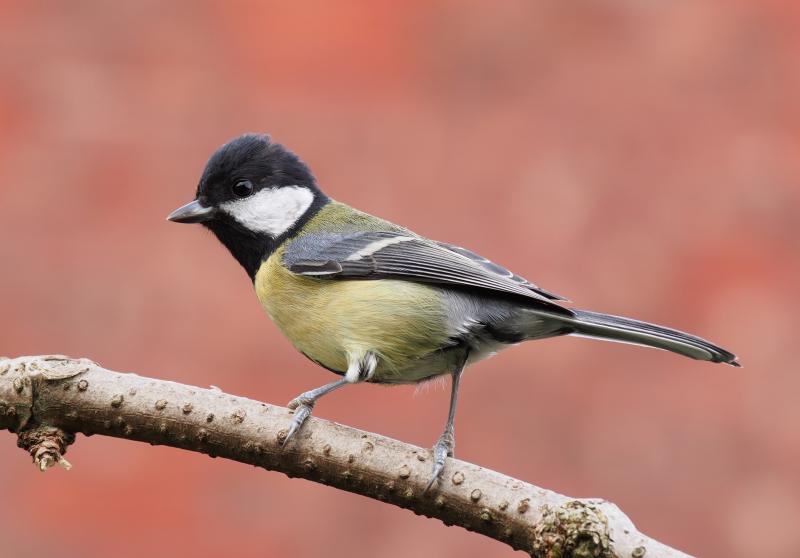Birds, Moths and Milk
Last month a new study was released that captured the attention of many science reporters in media outlets around the world. The headlines were usually some variation of: “Bird Feeding Found to Be Altering Evolution.” The study focused on a relative of our black-capped chickadee from Europe called the great tit. Bird enthusiasts in Great Britain have a long history of feeding birds; some estimates suggest that at least half of all British households regularly feed birds. Great tits, just like our chickadees, are one of the most common birds to visit feeders there.
In a detailed study, researchers found that great tits in Great Britain have developed slightly longer bills on average over the last 80+ years and that their bills are longer than those of great tits in mainland Europe where bird feeding is not as widespread. The scientists then looked at the genomes of the species and found genetic markers associated with birds that had longer bills. They took it one step further and showed that individuals with the long-beak genes were able to raise more young on average at their British study site than those with the shorter-beak genes.
So, although they don’t know exactly why, the researchers surmised that birds with the slightly longer beaks were better able to extract or handle seeds from feeders. Thus the intensive and long-term history of bird feeding in Great Britain may be causing evolutionary changes in Britain’s great tits.
Another study in the UK that was released a few years ago showed that a type of Old World Warbler (a different family from our New World Warblers) called the blackcap has developed, over recent decades, a population that stays in Britain for the winter rather than migrating to the Mediterranean region and Africa. That splitting of the wintering population was deemed the result of both a warming climate, as a result of climate change, and the provision of food at backyard bird feeding stations.
There are actually quite a number of examples of how human-caused environmental impacts have changed the course of evolution in a species. One of the most often cited examples in textbooks is of the peppered moth in England. These moths come in two forms: a white form that is camouflaged on white and grey tree trunks, and a black form that is camouflaged on dark tree trunks. Before the industrial revolution in England and the widespread burning of coal, the black form of the moth was quite rare. As soot and other pollutants began to darken tree trunks in many parts of the countryside, the black form of the moth became common and the white form less so. This was largely because birds ate the moths that were easier, which over time were the white moths on the darker tree trunks, with natural selection favoring the black form. Now that pollution has lessened in many parts of England as compared to those heavy coal-burning decades, white forms of the pepper moth have again become more frequent in the population.
Although not the same as evolution of the genome, British researchers many years ago demonstrated a fascinating phenomenon, called “cultural evolution,” in the blue tit, a close relative of the great tit. Back when milk was delivered in glass bottles and left on the doorsteps of customers in the early morning, an enterprising blue tit learned that it could open the cap and sip out the cream at the top. Other blue tits watched and learned. Soon the behavior had been passed around a large segment of the blue tit population in the area—all to the dismay of customers who suspected that unruly schoolboys were breaking into their milk supply!
In recent years, scientists have trained young great tits to open a small blue- or red-colored door in a special bird feeder to obtain seeds. When one of these trained birds is returned to its native flock, soon all of the other birds in the flock begin opening whichever door that original bird had been trained to open even though both doors were equally easy to open and both had the same seeds behind them. Soon just about every individual in the flock would show the same behavior.
It goes to show you that there’s a lot more going on out there among those birds that we love to watch then we might ever imagine!
Jeffrey V. Wells, Ph.D., is a Fellow of the Cornell Lab of Ornithology. Dr. Wells is one of the nation's leading bird experts and conservation biologists and author of “Birder’s Conservation Handbook”. His grandfather, the late John Chase, was a columnist for the Boothbay Register for many years. Allison Childs Wells, formerly of the Cornell Lab of Ornithology, is a senior director at the Natural Resources Council of Maine, a nonprofit membership organization working statewide to protect the nature of Maine. Both are widely published natural history writers and are the authors of the book, “Maine’s Favorite Birds” and the newly published “Birds of Aruba, Bonaire, and Curaçao” from Cornell Press.






























